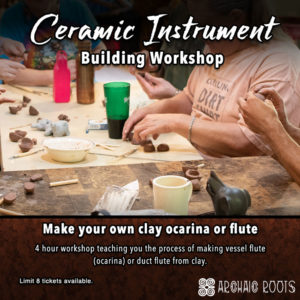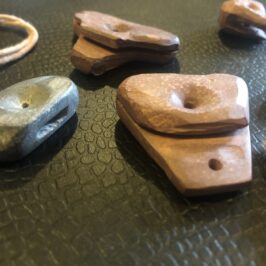The Native American Style Flute (Courting Flute or Duct flute)

Throughout history, many ancient musical instruments were more than just a means of producing pleasing sounds for someone to hear. They often had a deeper cultural or spiritual significance that was expressed through their construction, materials and uses.
Flutes of various kinds have been in use around the world for at least 50,000 years. However, the Native American style flute, “courting flute”, “love flute”, or duct flute, as it is also known, seems to be a rather common feature of the ancient First Nations cultural landscape. What do we really know about these instruments? Well, hopefully this article will expand your knowledge on the Native American Flute.
The Oral Origins of the Courting Flute
There are many variations of the courting flute origin story from each region or tribe, but they all seem to tell the same basic tale. In many versions of the story, a young man is smitten by a local girl but his attempts at courtship go unnoticed. He is either too boastful or too shy to catch her eye. In his sorrow, he seeks solitude in nature only to discover (or in some cases to be gifted) a hollow branch that seems to sing with the wind through holes caused by a woodpecker. After discovering that he can duplicate the songs of the forest by blowing into the branch, he creates beautiful music that catches the ear of his beloved. And of course, she is so moved by his song that she falls in love with him.
The Courting Flute in Daily Life

Each tribe or nation used the flute in many different ways. The Hopi for instance had “flute societies” that used flutes to perform powerful prayer ceremonies, venerated by the cicada this society and their group was thought to have power over water and rain.
Meanwhile the Lakota used flutes for courtship or love songs, each young man learning to make his own flute and song to hopefully win the heart of his chosen bride. Courtship was quite formal, and something to be witnessed by the entire community in Native American cultures. As a result, flute serenades were not uncommon as young men sought the attentions of young women. Once a match had been made however, it was common for the young man to lay down his flute, perhaps to signify that his courting days were over.
Legend of the first flute
A very long time ago there was a young man who was very interested in a beautiful young girl. He was always trying to get her attention, but she never seemed to notice him. Whenever she was present he would ride his horse proudly, but nothing he did seemed to attract her. One day when the girls were down by the river getting water, the young man went down to the river and began diving off rocks and swimming across the river, to show her how skilled he was, but again she paid him no mind. Dejected, the young man walked into the nearby old growth forest and sat down at the base of a long dead cedar tree. As he sat there thinking about this girl, a woodpecker landed on a hollowed limb that was over his head, the limb had been hollowed over time from the wind and weather. The woodpecker began to peck holes….tap, tap, tap……… along the length of this hollowed limb…….. tap. tap, tap…….as the woodpecker pecked, the limb broke off and fell next to the young man, and as the wind blew over this hollow limb with the holes in it, he heard musical voices coming from it. He picked it up and found that when he blew into this limb and covered the holes, he could make beautiful, mournful music to match the feelings in his heart. He sat there for a time making up haunting melodies. The young girl heard this music coming from the old growth forest, and it was such a soulful sound that it captured her heart. She followed the sound of music into the woods, where she saw him sitting there at the base of this cedar tree playing this first flute that was given to him by the Woodpecker, and as she listened she fell in love with his music and fell in love with him. They went off hand in hand to live happily ever after. One of the more popular uses for the Native Flute was for courting, to attract a mate. The legend also says that once you got a mate, you were to put the flute away and never play it in public again, because if you played it in public again, you might attract someone else? Phillip Brown Bear
Archaeological History of the Duct Flute


Getting back to the history of flute development, there are many types of duct flutes from Pre-Columbian cultures. Though some of the oldest rim-blown flutes date back to around 35,000 years found in 2008 at Hohle Fels, duct flutes developed at a later time.
- Clay ocarinas from present-day Mexico dated between 2,000 BCE.
- Clay flutes & whistling bottles from the Colima Culture in present-day Mexico dated to 1,000 BCE.
- North American duct flute (Native American style) flutes oldest specimen around 1,000 CE.
- The Medieval European Recorder, the earliest recorder we currently have dates to 1350–1399 CE.
It’s interesting that, unlike rim-blown and transverse flutes, the earliest existing examples of duct flutes in the Americas pre-date any examples of duct flutes from the rest of the world by thousands of years. It seems that duct flute technology was first developed in the Americas, when you look at the archaeological evidence, this technology and art flourished during a few thousand year period in the Americas. It wasn’t until the times of conquest that this culture slowly faded into history, that is until it’s fairly recent renaissance in the last few hundred years.
A recent article about whistling vessels also delves into this topic, read it here!
Current evolution of the contemporary flute
It seems that the traditional Native American style flute that we know today, may only be around 1,000 or more years old. The evolution of this technology has developed into finding an assorted and varied styles of Native American style flutes. These flutes are usually made of wood, but can be made from stone, clay, or man made materials.
As you can see in comparing the ancient Colima flute to the right and the contemporary drone flute below (made by Dana Ross of Falcon Flutes & Drums), the overall design and parts have changed very little in the last 2,000 years. Dana’s contemporary NA flute below has the same characteristic parts as the older Colima flute, though there are some dramatic differences in style and medium used. These two examples are drone style flutes, which have multiple chambers, basically just making multiple flutes into one. Both examples show the great craftsmanship that go into this type of art form.
Parts of the Native American Style Flute (Duct Flute)

Any flute that requires the player to make an embouchure, whether it is a rim-blown or side-blown (transverse), is going to be a challenge to learn to play. Some players give up on the flute before they develop their embouchure, and some players abandon the instrument when the constant practice needed to maintain their embouchure becomes discouraging.
Rim Blown Flute vs. Duct Flute
As you can see in the diagram to the left, a rim blown flute requires the instrument player to manipulate their mouth to create the ideal air flow into the splitting edge or notch. These types of flutes are ancestors of the duct flute, and are much easier to make but much harder to play. The technology of the duct flute made the learning curve for players much shorter, which created extra incentive to spread this technology across the trade routes of the Pre-Columbian Americas.

Innovative Technology
The duct flute includes innovative technology that uses parts of the instrument, rather than the player’s lips, to create the right setup for air to vibrate and create the frequency that we hear as sound. Though more complex to create, the duct flutes ease of use made this technology a valuable asset in the Pre-Columbian world.

The duct (aka “flue”) is a shallow/narrow channel that directs the air across a sound hole into the splitting edge of the instrument. The image to the left shows how the air (moving from right to left) comes out of the flue, crosses the sound hole, hits the splitting edge, and sets up a vibration.
This air vibration happens because of the specific shape of all the aspects of the flute, but in particular the shape of the flue, the sound hole, the splitting edge, and the bore size and length of the flute’s sound chamber.
Duct Flute Technology Trade-offs
Creating a sound on a duct flute is a natural extension of the player’s breath. The player simply breathes into the flute and the instrument sets up the air vibration that creates a sustained note.
However, since these flutes essentially have a “fixed embouchure”, the player cannot control the shape of the embouchure like on a flute where the player’s lips can be adjusted. So, in exchange for ease of play, there are some trade-offs:
- The range of duct flutes tends to be more limited than rim-blown or transverse flutes.
- The flue can gather moisture from the player’s breath. The shape of the flue is critical to the sound that is created, accumulated moisture can affect sound quality and even disrupt the sound altogether.
- Harder to make in duct flutes more advanced technology
Science meets spirit
”They were probably vital for conjuring up the supernatural, for protection, for religion and culture,” he speculated. ”The care that went into making these instruments suggests that they were more than diversions or toys.” Dr. Olsen
There have been a few different articles and research papers written about the various instruments of precolumbian cultures. Some interesting research by Dr. Dale A. Olsen, of the Florida State University school of music, into the instruments of the Tairona of northern Colombia bring up some interesting points. His research found that these instruments when played together usually created binaural frequencies. These binaural tones can increase relaxation; change the production of hormones in the body; reduce anxiety and stress, by creating a auditory illusion of the two tones creating a third tone. The production of binaural frequencies have also been known to help induce meditation and trance states, help with pain management, improve sleep, and reduce stress; these findings are discussed in the study “A Comprehensive Review of the Psychological Effects of Brainwave Entrainment”, Tina L Huang, PHD, and Christine Charyton, PHD.
Sacred Instruments
This capability to create these frequencies and induce trance states, their burial locations, and the development of the art and technology of these flutes; leads us to assume that these instruments were considered sacred and used in ceremonies. In contemporary indigenous cultures of these regions, we see the echoes of ancient practices and reverence for these types of instruments in ceremony. The ancient Colima drone flute pictured above had a frog motif integrated into it’s design, considering the practices of animistic cultures, it’s safe to conclude that this flute probably was associated with the frog spirit in some way. The ancients probably played this specific flute in ceremony to call the frog spirit, which related to rain or change and adaptability, we may never honestly know.












